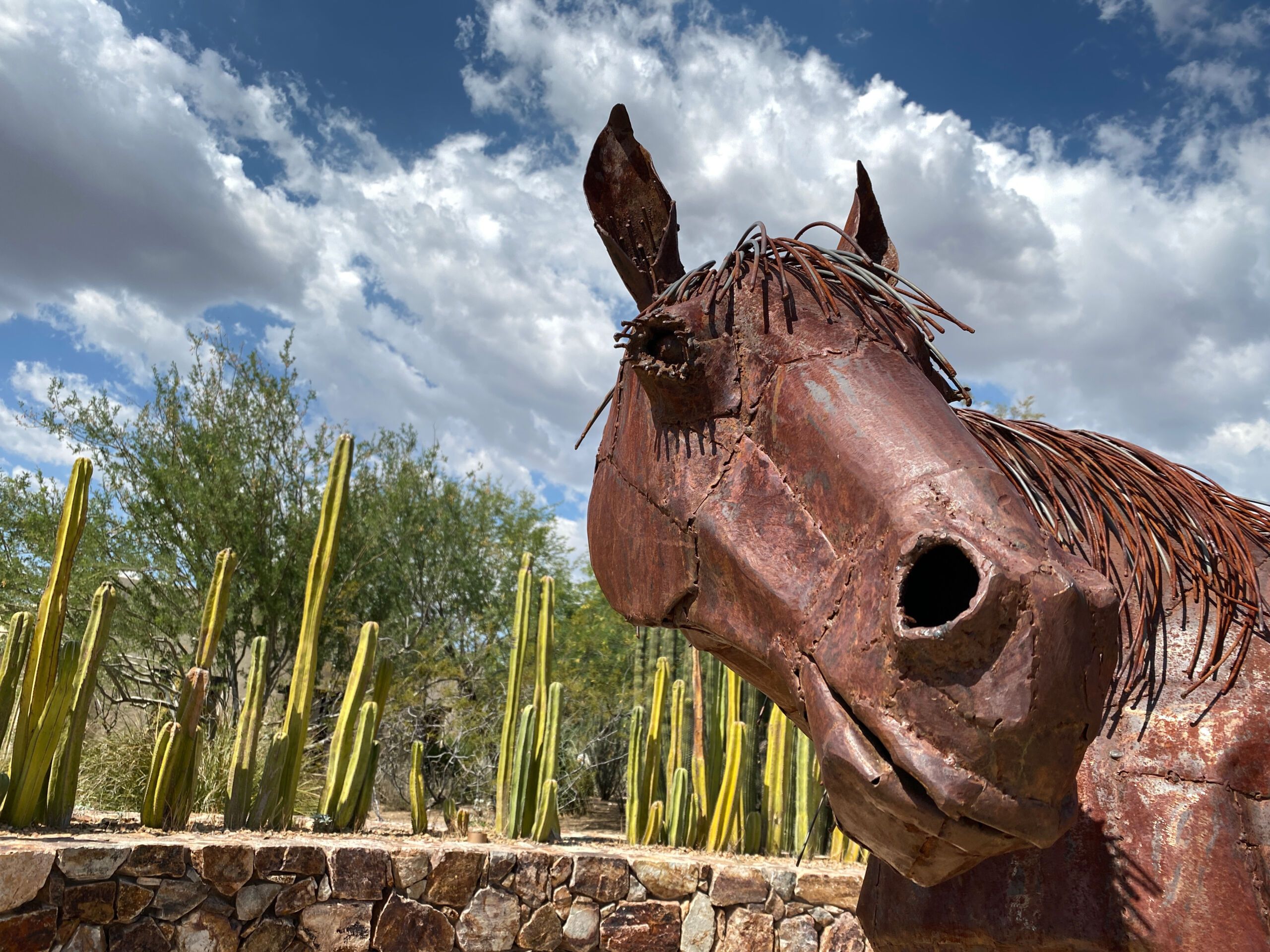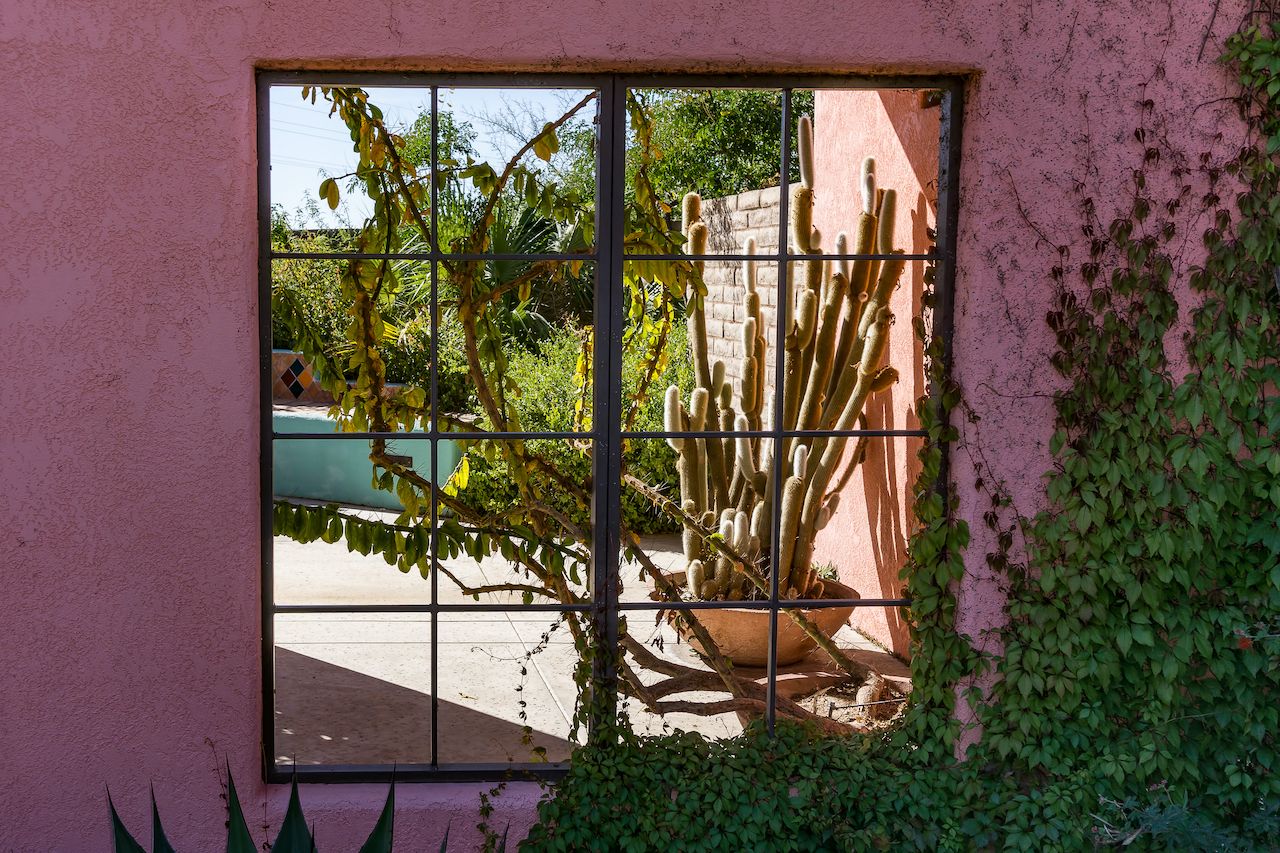Tucson’s population of 540,000 people is scattered across more than 200 square miles of sandy urban sprawl. If your goal is to hike or mountain bike the Santa Catalina Mountains, you’ll find it takes a bit of driving past fast-food joints and housing complexes to escape civilization. But keep heading north toward Oro Valley and on your way to the Catalinas you’ll find a delightful desert oasis tucked just off SR77, across the road from urban mainstays like Whole Foods and Starbucks — the Tohono Chul gardens, galleries, and bistro. These sprawling, estate-like grounds, officially called the Tohono Chul Botanical Gardens and Galleries, is a celebration of Sonoran Desert natural habitat, art, and culture.

Tohono Chul Is the Desert Oasis Everyone Should Visit in Tucson
Tohono Chul is a must-visit destination if you’re visiting Tucson, but before you imbibe one of the bistro’s famous prickly pear margaritas, there are a few things about the gardens you should know. Start your Tohono Chul visit by wandering the desert gardens and learning about the prickly pear cactus and its fruit — pink and purplish buttons that produce sweet, nearly neon-pink juice. They’re called tunas in Spanish and they’re in season in the summer through the fall months. A chilled prickly pear margarita is even more satisfying when you know a little bit about the colorful fruit — and after you’ve wandered the park in midday sun for an hour or so.

Photo: Cathryn Castle
The story of Tohono Chul starts in the mid-1960s when its benefactors, geologist Richard Wilson and his wife Jean bought the property where the gardens are now located. Developers came calling throughout the 1970s, but the Wilsons wouldn’t sell. According to Tohono Chul’s archives, Jean said of her decision, “I don’t want to sell the land. I don’t want it cemented over. I want to preserve it.”
The pair established the nonprofit Foundation for the Preservation of Natural Areas in the early 1980s. Historical documents preserved by Tohono Chul record Jean explaining the couple’s mission: “We wanted to keep something natural in the middle of all the (surrounding) development so that people could come easily for a few hours and get out of the traffic and learn something at the same time.”
Both Jean and Richard have since passed away, but the legacy they created is thriving. Today the park is supported by donations and nominal entry fees. Volunteer docents are available to guide you, or you can grab a park map and enjoy your own adventure.
Flora and fauna at Tohono Chul Park
The words “tohono chul” mean “desert corner” and are from the language of the early Tohono O’odham people, hardy desert-dwellers renowned for their knowledge of Sonoran plants.
Today, the curated desert garden consists of 49 acres of trails and gardens that highlight the Arizona Upland subdivision of the Sonoran Desert — one of six distinct regions of North American desert and offering more varieties of trees, shrubs, cacti, and other succulent plants. Tohono’s collection consists mostly of plants native to the region or adapted to the American Southwest, including more than 150 species of shrubs and trees, 300 species of cacti and succulents, and 50 species of wildflowers.
The Santa Catalinas rising in the distance provide the perfect backdrop for the natural experience, although it’s important to note that Tohono Chul’s location does more than provide a pleasant diversion for city folk. Wildlife have found a refuge within the gardens: Nearly 40 bird species make their permanent home here, and another 60 or so migrant species fly in and out seasonally. Other desert creatures often spotted here include jackrabbits, gila monsters and other lizards, bobcats, coyotes, and even gray foxes. Native tortoises even have their own preserve.
Just beyond the Sonoran Seasons Garden to the west is the Desert Palm Oasis, which is a careful recreation of a tropical forest found near the town of San Carlos, Mexico (six hours’ drive south of Tucson). Here, you’ll find towering tropical palm trees, including three species of fan palms. The oasis is a celebration of the Sonoran Desert’s diverse plant life.
Attractions at Tohono Chul

Photo: Nelson Sirlin/Shutterstock
While there are many botanical gardens in the United States, there is natural beauty everywhere you look at Tohono Chul Park, and the park features sculptural art created by local artists, and the entire park is set up as an educational center. The Geology Wall illustrates the geologic history of the Santa Catalina Mountains and the Saguaro Discovery Trail explains both the natural history and cultural significance of the towering cactus.
More adventurous visitors will enjoy walking the Hallowell Desert View Trail. It’s only about a half-mile long, featuring the desert in its natural state. Along the trail are two shaded ramadas with drinking fountains, but this trail is not wheelchair accessible.
The area known as Cholla Forest features “jumping” cactus that, although it doesn’t really jump, has an uncanny ability to attach to your clothing (or skin) if you happen to brush against it. The cholla cactus’ stems are covered in barbed spines. The stems detach easily, so do be careful not to get pin-cushioned. Although if you do brave the Cholla Forest, chances are you’ll see birds including the cactus wren and curve-billed thrashers — they love building their nests in the cholla. Also keep an eye out for Gambel’s quail, and the ubiquitous desert roadrunner.
Dining at the Tohono Chul Garden Bistro
Once your desert wandering is done, you’ll feel like you’ve earned a prickly pear margarita or two (there’s also a nonalcoholic prickly pear lemonade), or a local draft beer. The Tohono Chul Garden Bistro offers indoor, air-conditioned dining, or you can enjoy the outdoor dining area, adjacent to the Hummingbird Garden, which features a variety of plants attractive to hummingbirds. While the hummingbirds feast on the nectar of honeysuckle, agave, and salvia, you can satisfy your hunger with a classic burger and fries, brunch fare such as waffles or an omelet, or try one of the Bistro’s Sonoran-inspired dishes.
And guess what? The prickly pear margaritas are “bottomless” when ordered with an entree. The hummingbird show and the slow-going Sonoran vibe at Tohono Chul invites you to stay a while longer. Summers are long here. Hiking and mountain biking can wait.
Visiting Tohono Chul
Now that you know you need to make a detour in Tuscon to stop at these gardens, there is some basic info that everyone who visits Tohono Chul gardens needs before embarking on a visit. The pratical tips for visiting the park include how much it costs to gain entrance to the park, and whether or not the park is pet friendly. Here is everything you need to know before arriving at Tohono Chul.
How much is admission to Tohono Chul?
General admission for adults is $15 but if you bring a big group (10 or more people) you get a 10 percent discount. Students, seniors, and active members of the military get a $2 discount. Children ages 5 to 12 years old are only $6 (and children younger than that are free).
How big is Tohono Chul?
The gardens cover 49 acres, so you should expect to do plenty of walking while you’re there. In the summer, temperatures in Tuscon can reach the upper nineties, so you can except to sweat. Wear light clothing, don’t forget to apply plenty of sunscreen, and make sure you have a full water bottle when you enter the property so you can stay hydrated as you walk. Exploring is best done safely.
Can dogs go to Tohono Chul?
While service animals are more than welcome in the gardens, all other pets are not allowed on the property. While we love our canine companions, high energy animals (even if hteya re domesticated) are prone to destroying vegetation and trampling grass, flowers, and other flora and fauna. They might even hurt themselves on the many cacti in the gardens. If you’re planning to visit the gardens, best to leave your dog at home, as it is not safe to leave them in the car either.
Where: 366 Paseo del Norte, Tucson, AZ 85704
